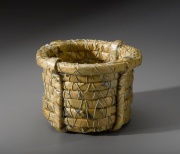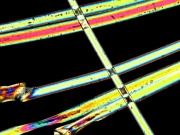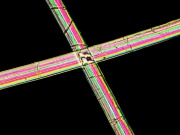Difference between revisions of "Polyethylene fiber"
| Line 33: | Line 33: | ||
[[File:61 Spectra 900 200X pol.jpg|thumb|Spectra 900]] | [[File:61 Spectra 900 200X pol.jpg|thumb|Spectra 900]] | ||
| − | |||
| − | |||
| − | |||
| − | |||
== Comparisons == | == Comparisons == | ||
Revision as of 17:37, 20 May 2020
Description
A manufactured fiber made from the polymers or copolymers of ethylene. Ethylene was first polymerized in 1933 by ICI in England. In 1954, Karl Ziegler developed a process for higher weight polyethylene that allowed it to be spun into fibers. These fibers, from High density polyethylene, are lightweight, smooth and white with a slightly waxy feel. They are resistant to wear, creases, acids, alkalis, moisture, fungi and insects. Polyethylene fibers do not accept dyes, so they are colored by mixing pigments in the molten polymer prior to extrusion. The fibers slowly degrade in sunlight and can be stained by oils. Polyethylene fibers are used to make waterproof paper (Tyvek®), ropes and fabrics for upholstery for industrial and outdoor applications.
Synonyms and Related Terms
polyethylene fibre; polyolefin; olefin; high density polyethylene fiber; HDPE fiber; Tyvek® [DuPont]; Reevon; Wynene; Velon; Courlene; Drylene; Spectra® [AlliedSignal]; Dy-neema® [Toyoba/Dyneema];fibras de poliolefinas(Esp.)
Applications
Risks
Burns with a heavy, sooty, waxy smoke. Degraded by ultraviolet light and sulfur containing pollutants. May contain additives ( such as antioxidant BHT) that can migrate and cause staining.
Physical and Chemical Properties
Soluble in perchloroethylene (do not dry-clean) and most chlorinated and aromatic solvents when gently heated. Resistant to strong acids, alkalis, bleaches. Cross sections = circular or elliptical.
For HDPE fibers: Tenacity = 5.0-8.0 g/denier; Moisture regain =
| Melting Point | 130-138 |
|---|---|
| Density | 0.95-0.96 |
| Refractive Index | 1.52 |
Comparisons
Properties of Synthetic Fibers
Sources Checked for Data in Record
- Hoechst Celanese Corporation, Dictionary of Fiber & Textile Technology (older version called Man-made Fiber and Textile Dictionary, 1965), Hoechst Celanese Corporation, Charlotte NC, 1990
- Rosalie Rosso King, Textile Identification, Conservation, and Preservation, Noyes Publications, Park Ridge, NJ, 1985
- Identification of Textile Materials, The Textile Institute, Manchester, England, 1985
- Fairchild's Dictionary of Textiles, Phyllis G.Tortora, Robert S. Merkel (eds.), Fairchild Publications, New York City, 7th edition, 1996
- J.Gordon Cook, Handbook of Textile Fibres:II Man-made Fibres, Merrow Publishing Co. , Durham, England


